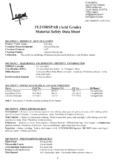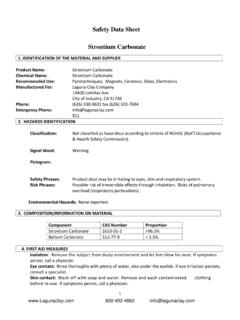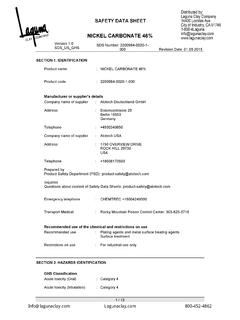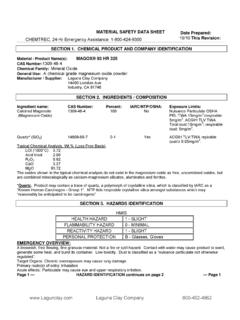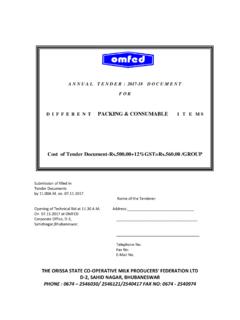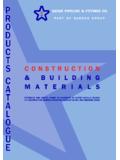Transcription of RAW MATERIALS R INTRODUCTION AW LIABILITY …
1 RAW MATERIALS . INTRODUCTION . R. As a major supplier of raw MATERIALS to the ceramic industry, we strive to offer our customers consistent, top quality MATERIALS that are competitively priced. On the following A. pages you will find a listing of chemicals and MATERIALS currently available from Laguna Clay Company. These products are listed in the following sub-categories: MATERIALS , Raw Clays, Frits and Stains. It is our intention in preparing this section to give you, the user, as much information as possible about these products. When available, the W. chemical formula of the material is given. We hope this section is useful to you as a reference guide to MATERIALS relevant to the ceramic field. LIABILITY STATEMENT. The MATERIALS available through this catalog are in grades of purity which are most useful in the ceramic industry. Some of them are not pure compounds, and therefore, M.
2 We are unable to warrant the consistency of these MATERIALS from batch to batch. We urge you to make thorough tests every time a new material or lot is purchased. A. HEALTH CAUTION. An ever-increasing number of the earth's raw MATERIALS are reported to contain elements deemed toxic, carcinogenic, or a potential health hazard. Utilizing information T. provided by California Proposition 65, SARA Title III and manufacturers' material Safety Data Sheets (MSDS), we have identified these raw MATERIALS with an asterisk. The MSDS describes the nature of the potential hazard as well as recommendations for safe use of the material . For a copy of the MSDS, visit , E. or contact Laguna at (626) 330-0631 or R. I. A. L. DRY RAW MATERIALS S. ALBANY SLIP SUBSTITUTE* Through years of formulation and reformulation, Karl Miller developed Albany Slip Substitute which is intended to reproduce the SG-328 physical and performance characteristics of the famed Albany (NY) Slip once mined only two hours from Miller's ceramic lab.
3 See also Alberta Slip clay and Arroyo Slip clay. ALBERTA SLIP CLAY* A popular Canadian blended substitute for the old Albany (NY) Slip. Albany Slip was frequently used as a glaze additive, and boasted a high proportion of fluxes, which combined with a very fine grain caused it to melt at around 1240 C. See also Albany Slip Substitute and Arroyo Slip. ALUMINA HYDRATE The usual source of alumina in glazes. Al(OH)3. ALUMINA OXIDE Responsible for the mattness or brilliance of glazes. Prevents devitrification and adds strength. Insoluble in water and melts at AI203 3550 F. Use of too much alumina can cause a dry appearance. ANTIMONY OXIDE* Derived principally from stibnite, it is used in combination with rutile and titanium in pottery as a yellow body stain and frequently Sb203 it is used in glass as a decolorizing agent and in ruby red compositions.
4 ARROYO SLIP CLAY* A naturally occurring slip glaze mineral. Very similar in color and texture to Albany Slip. BARIUM CARBONATE* This is the main source of barium oxide in glazes where it functions as a flux and assists in producing matte finishes. It is also BaC03 used to neutralize sulfates in clay bodies. We recommend German barium carbonate for use with clay and either German or Chinese barium carbonate for use in glazes. BENTONITES* A very plastic magnesium clay containing colloidal matter which in small amounts lends plasticity to a clay body. Also used as a suspending agent in glazes. 325 MESH We recommend Bentonite 325 mesh as a standard glaze and clay additive. BENTOLITE L-10 Our whitest Bentonite. For use in clay bodies, especially in conjunction with Macaloid in porcelains. HPM-20 Ultra-fine ground, air-purified Bentonite recommended when a finer grade than 325 is needed for glaze applications.
5 IBEX-200 Low-grade California Bentonite. MACALOID (BENTONE MA) A suspension agent which increases the drying rate of water suspended glazes. It is similar to a very clean, white type of Bentonite. Also used as a plasticizer in fine porcelain. VEE GUM CERAMIC A blend of Vee Gum-T and CMC for use in glazes. VEE GUM-T A macaloid-type Bentonite suspension agent for glazes. Also used as a surface hardener. It is an extremely plastic, hydrous magnesium silicate used to give plasticity to non-plastic whiteware and refractory bodies. Very similar to Macaloid. * Refer to the Health Caution paragraph at the beginning of the Raw MATERIALS Section. Contact for the Laguna distributor in your area 63 Prices exclude freight and are subject to change without notice BONE ASH An important source of calcium phosphate. When added to a clay body such as bone china, it lowers the maturing temperature R Ca3(P04)2 CaC03.
6 BORAX. and adds translucency. Also used to give texture in low fire glazes. A water soluble, low temperature flux which lowers the fusion point of glazes and promotes a smooth melt. Produces bright A Na20-2B203 colors with oxides. Also a source of sodium and boric oxide in glazes. Available in granular and powder. W CARBOXY/METHL CELLULOSE. ( ) POWDER. An organic cellulose gum which functions as a thickener, binder and suspending agent in glazes. Mix with water to dissolve and age before adding to a liquid glaze. CALCIUM BORATE CADYCAL A precipitated calcium borate mineral. Ca2B6O11 - 5H20. M CALCIUM CARBONATE* The most common source of calcium in glazes. It is a high temperature flux which gives durability and hardness to glazes. A CaC03. CALCIUM NITRATE. Includes Whiting, Vicron, Marblewhite, and Atomite. A water soluble compound that is used as a thickener in glaze preparation.
7 T Ca(No3) E CHROMIUM OXIDE-GREEN*. Cr203. A versatile colorant used in glazes to produce various green tints. R COBALT CARBONATE*. CoC03. A fine particled, lavender powder used as a glaze colorant and for brushed decoration. Produces various shades of blue and when manganese is present can give purple. I COBALT OXIDE* A reliable, stable black powdered oxide. In small amounts it produces consistently strong blue tones. Used as a glaze colorant A Co304, Co0. COBALT SULFATE*. and brushing oxide decoration. A water-soluble reddish powder, sometimes used in white clay bodies and glazes to create a whiter appearance as a result of L imparting a bluish tint; in other words, a cold white vs. a warm white. S COPPER CARBONATE*. CuCo3 (0H)2. A green powder used as a glaze colorant. Depending on conditions and formulation it may produce green, blue-green or copper red.
8 COPPER OXIDE-BLACK* This is the oldest glaze colorant known. It is a strong flux and will produce fluid glazes. Can produce copper reds in reduction Cu20 firing. CORNWALL STONE* A type of spar used in clay bodies to give strength while firing. Also used in engobes because of its adhesive properties. With the addition of a suitable flux, Cornwall Stone can be used as a glaze. Sometimes called English Cornish Stone. CRYOLITE Synthetic Cryolite (Kryolite). A strong fluxing agent with a very low melting point. A good sodium-alumina source. Occasionally Na3Al F6 used as an opacifier for enamels, or to produce crackle glazes. DEXTRIN An organic binder used mostly with plaster. DOLOMITE (Dolowhite)* Useful as a source of calcium and magnesium. It can be used as a high temperature flux and also to promote crystal formations. CaMg (C03)2. DYES (Water Soluble) Aniline Brown Blue 2-B Methylene Methyl Violet 125%.
9 Black 12525 Red Rhodamine B Yellow Victoria Green The above colors are commonly used by manufacturers to color code similar appearing clay or glaze batches. ERBIUM OXIDE A pink colorant used in the manufacture of crystal glass and ceramic glazes. Used in glaze as a pure oxide versus stain, excellent transparency and translucency can be achieved. See also, neodymium oxide and praseodymium oxide. FELDSPARS:* Crystalline minerals made up of mainly alkaline silicates. Used extensively in both clay and glaze formulation. CUSTER A standard potash spar used in clay and glaze formulas. Mined in Custer, South Dakota. G-200 A potash spar, low in impurities, well suited for white glazes and porcelain clay bodies. KONA F-4 (Soda Spar) A widely used eastern soda spar. PRIMAS P A Mexican potash feldspar for use in clay bodies and glaze formulas.
10 FELDSPAR TYPICAL ANALYSIS CHART. SILICON ALUMINA IRON CALCIUM MAGNESIUM SODIUM POTASSIUM LOSS. DIOXIDE OXIDE OXIDE OXIDE OXIDE OXIDE OXIDE ON. NAME SiO2 Al2O3 Fe2O3 CaO MgO Na2O K2O IGNITION. Custer Trace G-200 Kona F-4 Primas P * Refer to the Health Caution paragraph at the beginning of the Raw MATERIALS Section. Ceramic Supplies & Solutions Since 1932 64 (800) 4-LAGUNA (626) 330-0631 FLUORSPAR This crystalline mineral has a lower fluxing temperature than other calcium compounds. It can be used as a substitute for whiting CaF2. GERSTLEY BORATE. to promote more fusible glazes. Insoluble in water, it should be used at 100 mesh or finer or it can cause mottling in glazes. A sodium-calcium-borate compound used as a low temperature flux which helps prevent crazing. Can act somewhat as an R. opacifier. Standard substitute for Colemanite.


